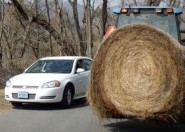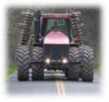Sometimes, Half the Road Is Not Enough™: A Public Safety Awareness Message to Improve Farm Equipment Safety on Public Roadways
ID
AAEC-70NP
This fact sheet is a product of the 2014 Spring Kohl Centre Experience. To find out more about this project team and related information, please go to the Kohl Centre at Virginia Tech’s website: https://aaec.vt.edu/extension/kohl-centre.html.
Introduction
Farming is a dangerous occupation due in large part to the many different roles that farmers find themselves in every day including truck drivers and equipment operators. Transportation of farm equipment on public roadways is a very dangerous component, as equipment is large, often unwieldy, and with slower response times. The 2011 Bureau of Labor Statistics reported that farmers and ranchers were ranked fourth in the nation in number of work-related deaths, and most sources agree that the greatest danger in this occupation is heavy machinery operation. The focus of this fact sheet is to promote safety on Virginia’s public roadways to provide farmers and ranchers the peace of mind that transporting machinery on roadways can be done without as many life-threatening close calls. During the planting and harvesting seasons of spring and fall, Virginians are encouraged to take extra care when maneuvering on rural roadways, and to allow extra time and space when farm equipment operators are sharing the roads.

To move farm machinery from each location operators are permitted to use public roadways. According to a study in Iowa, the most common type of farm equipment versus vehicle collision on public roads is a rear-end collision (Lehtola et al., 1994), which accounted for 43% of all collisions. Farm machinery operates at a maximum of 30 miles per hour, but cannot maintain these speeds in turns or up hills. In fact, older farm equipment has a maximum speed closer to the 14-18 mile per hour range or less. On rural roadways, speed limits are typically 45 mph or unmarked, which legally implies the speed limit is 55 mph. Traveling at these speeds when approaching a piece of traveling farm equipment requires sufficient braking time and extra patience. To demonstrate response times, a motorist traveling at 55 mph and approaching a tractor moving at 15 mph will close a gap the length of a football field in just five seconds.
Safe passing is a major issue when motorists and farm machinery are on the same roadway. Often the first reaction of motorists when behind a piece of farm machinery on a public roadway is to pass the farm machinery as soon as possible. Too few times do we consider how long and how wide the object in front of us (or approaching us) really is. Today’s farm implements are bigger on average than those built in the 20th century, but rural roadways remain unchanged in terms of size and straightness. Anecdotal reports from farmers who operate agricultural equipment on public roadways reveal concerns of increasingly unsafe pressure from passenger vehicles encounters. The author has experienced near-miss situations which matched those of the farmers interviewed by the Kohl Centre team. Unsafe passenger car maneuvers reported by farm machinery operators include passing in the grass on the right side of the road, passing on blind turns with a vehicle oncoming in the opposite lane, and excessive use of the brakes to prevent an accident. Motorists approaching a piece of moving farm machinery are encouraged to slow down, observe the road conditions and machinery signage and profile, and check for any signaling from either the equipment or the operator before attempting to pass. Crashes involving farm equipment and passenger vehicles were shown to result in death of the farm equipment operator nearly twice as often as the passenger vehicle motorist (Committee on Agricultural Safety and Health Research and Extension, 2009), as the farm equipment is designed with larger tires, operator seating is high and/or off-center, and the machines are easily unbalanced when road surfaces change abruptly or obstacles interfere with the forward motion.

The purpose of this fact sheet is to provide information to passenger vehicle motorists about the need for taking added precautions when maneuvering around farm equipment on public roads. After interviewing several of Virginia’s farmers who frequently operate farm machinery on roadways, public safety awareness commercials and radio spots were prepared for use by local radio stations during peak planting and harvesting seasons to raise motorist awareness. In addition, a bumper sticker that depicts the size of farm machinery relative to rural roads and states “Sometimes, Half the Road is Not Enough™” was created. Narrated videos were developed and posted on the Kohl Centre YouTube channel. Future plans include sharing this fact sheet for use in driver education courses in hopes of educating young and beginning drivers about safe maneuvering around farm machinery on a public roadway.
Transport widths of modern farm machinery can reach sizes of 18 feet, in some cases even wider, but rural roadway lane widths average between 9 and 12 feet (Federal Highway Administration, 2007). Even without other common roadway constraints such as mailboxes and narrow bridges, if you are confronted with a piece of farm machinery on a public roadway, be aware that “Sometimes, Half the Road is Not Enough™”. The Kohl Centre of Virginia Tech asks that this season, please be patient on rural roads and give farm machinery operators the room to maneuver safely.

For more information about Farm Equipment Safety on Public Roads, please contact Dr. Kimberly M organ at KLMorgan@vt.edu. “closed,” which means there is not a blank space on either side.
Works Cited
Bureau of Labor Statistics. 2011. Fatal occupational injuries, total hours worked, and rates of fatal occupational injuries by selected worker characteristics, occupations, and industries, civilian workers. U.S. Department of Labor, Washington, D.C. May 5, 2014.
Committee on Agricultural Safety and Health Research and Extension. 2009. Agricultural Equipment on Public Roads. Cooperative State Research, Education and Extension Service, U.S. Department of Agriculture, Washington, DC. January 25, 2014. Link: https://nasdonline.org/static_content/documents/2065/d001906.pdf
Federal Highway Administration. 2007, July. Mitigation Strategies for Design Exceptions: Chapter 3: The 13 Controlling Criteria – Lane Width. U.S. Department of Transportation. April 30, 2014. Link:
https://safety.fhwa.dot.gov/geometric/pubs/mitigationstrategies/chapter3/3_lanewidth.cfm
Lehtola, C.J., Marley S.J., Melvin S.W. 1994. A study of five years of tractor-related fatalities in Iowa. Appl. Eng Agr 10(5):627-32Iowa. Appl.
Additional Resources
Resources for this project were provided by the Kohl Centre. The Kohl Centre serves a dual mission: (1) To provide business, financial, marketing and management advice, using the resources of Virginia Tech students and faculty, in the entrepreneurial spirit of Dr. Dave Kohl; and (2) To facilitate action-oriented, immersive professional development project opportunities for Kohl Centre Teams in response to identified clientele needs. Please visit https://aaec.vt.edu/extension/kohl-centre.html for more information.

Virginia Cooperative Extension materials are available for public use, reprint, or citation without further permission, provided the use includes credit to the author and to Virginia Cooperative Extension, Virginia Tech, and Virginia State University.
Virginia Cooperative Extension is a partnership of Virginia Tech, Virginia State University, the U.S. Department of Agriculture, and local governments. Its programs and employment are open to all, regardless of age, color, disability, sex (including pregnancy), gender, gender identity, gender expression, national origin, political affiliation, race, religion, sexual orientation, genetic information, military status, or any other basis protected by law
Publication Date
May 20, 2020



